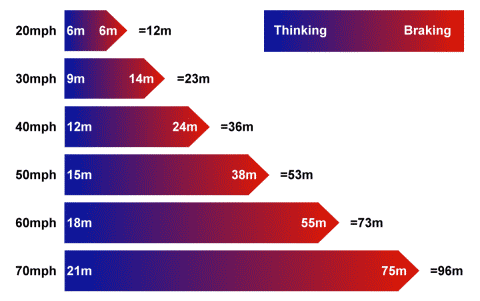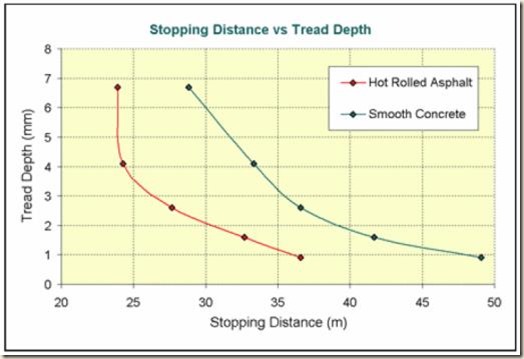I thought I’d update this article yet again as I’m currently getting a lot of hits from people looking for ‘overall stopping distance’ and ‘stopping on ice’. I also get quite a few people looking for motorbike stopping distances.
This diagram shows stopping distances in metres (which are easier to remember).
First of all, for motorbikes, all the Highway Code (HC) says:
126
Stopping Distances
Drive at a speed that will allow you to stop well within the distance you can see to be clear. You should
- leave enough space between you and the vehicle in front so that you can pull up safely if it suddenly slows down or stops. The safe rule is never to get closer than the overall stopping distance (see Typical Stopping Distances [chart above])
- allow at least a two-second gap between you and the vehicle in front on roads carrying faster-moving traffic and in tunnels where visibility is reduced. The gap should be at least doubled on wet roads and increased still further on icy roads
- remember, large vehicles and motorcycles need a greater distance to stop. If driving a large vehicle in a tunnel, you should allow a four-second gap between you and the vehicle in front
If you have to stop in a tunnel, leave at least a 5-metre gap between you and the vehicle in front.
There are no official stopping distances specifically for motorcycles that I’m aware of. The Highway Code just says motorbikes need to allow a greater distance to stop. In any case, stopping distances are theoretical and depend on various external factors. Any chart is only for guidance, and these stopping distances from the HC are based on a well-maintained vehicle with good brakes and fitted with tyres having plenty of tread.
RoSPA carried out some tests in 2005 and measured stopping distances versus different tyre tread depths (at a fixed speed).
They found that overall stopping distance increases dramatically when tread is less than 3mm and recommend that tyres be changed at this point.
Obviously, tyres cost money. For that reason many people avoid replacing them until it is absolutely necessary. However, I would suggest that many bumps and even some more serious accidents might have been avoided if people had had their tyres replaced sooner.
Remember that if you are stopped by the police and found to have defective tyres then you could lose your licence – especially if you’re a new driver on the two-year probationary period who perhaps already has points. Remember, too, that someone who lets their tyres go below the legal minimum of 1.6mm is likely to have let other things slip as well, and the police will almost certainly check for other defects if they find your tyres are bald.
What is the legal minimum tread depth?
The specification is that tyres should have a minimum of 1.6mm of tread across the middle three-quarters of the tyre’s surface, and this should apply for the whole circumference.
How can I measure my tread depth?
Use a proper tyre tread tool, available for a few pounds from a motorists’ store. Alternatively, the little ring of dots on 10p coins (newer coins don’t have them) is about 1.6mm from the edge of the coin. If your tread is anywhere near 1.6mm, get your tyres replaced urgently.
How can I remember stopping distances?
First of all, you can try and use your memory. It’s easy to remember the different speeds from 20mph up to 70mph. Similarly, the “thinking distance” starts at 6m and goes up by 3m for each 10mph step. All you have to do then is memorise the overall distances, which allows you to calculate the “braking distance”.
There is also a way to calculate overall stopping distance in feet using a little mental arithmetic. All you do is square the speed you’re doing in mph, divide by 20, then add the mph you had at the start to get the answer. For example:
- At 20mph: 20 x 20 = 400; divide by 20 = 20; add 20 = 40 feet
- At 70mph: 70 x 70 = 4,900; divide by 20 = 245; add 70 = 315 feet
You can convert this to approximate metres by multiplying by 3, then dividing by 10, so:
- For 40 feet: 40 x 3 = 120; divide by 10 = 12 metres
- For 315 feet: 315 x 3 = 945; divide by 10 = 94.5 metres
It’s only approximate, but it is close enough to get the answer when you’re doing your Theory Test.
Is it vital to know stopping distances?
Well, in order to pass your Theory Test (assuming a question comes up, and assuming you want to get it right), yes.
Personally, I don’t think that knowing the actual numbers is of any direct benefit for seasoned drivers. The main thing is to understand how the distances increase the faster you’re going, which means you should allow for this when you’re driving. Learning the stopping distances when you first start your lessons helps you develop that understanding.
If you assume that a typical car is 4m long, a stopping distance of 96m (315 feet) is equivalent to about 24 car lengths – or approximately 150 paces for someone of average height. That’s a long way.
The 2-second rule is of far greater practical application in day-to-day driving.
What is the stopping distance when it’s wet?
There are no tabulated figures, because the term “wet” can mean anything from a bit damp to under several inches of water! The stopping distance chart applies to good tyres on a good surface under good conditions – and even then you cannot possibly know how close you are to all those “good” conditions.
The HC advises that you allow for a following distance of at least 2 seconds (‘the 2 second rule’) in good conditions, and to at least double that (4 seconds) in the wet. Note that the HC doesn’t say how long it will take to stop when it’s icy – it just says it will take a lot more than a 2 or 4 second gap will allow for.
Maintaining a safe distance like this gives you time to react and stop – and that’s where your overall stopping distance fits in.
The whole point of the stopping distance chart is that you recognise the overall distances involved – not that you quickly do a load of maths in your head every time you brake, or attempt to drive as close as you can to someone in front. After a bit of experience you will be capable of recognising what amounts to “too close”.
What is the stopping distance on ice or snow?
There isn’t one. Trust me, if you’re going too fast on even the gentlest downward slope in snow or on black ice and you brake, there is every chance that you won’t stop until you collide with something. Some sources say it can take up to ten times the normal stopping distance, but that’s far too specific for something that is virtually impossible to measure accurately.
How quickly you stop on ice or snow (or mud, or leaves, or oil) depends on the temperature, the type of slippy stuff you’re on, how thick it is, how compact it is, and many other factors.
I’ve already mentioned the gradient, which has a dramatic effect – skid uphill and you’ll stop thanks to gravity, skid downhill and gravity may well cause you to speed up once you start to slip. There are a few hills on my patch which are impassable in winter if it snows – in either direction. You either can’t get up them, or you can’t stop if you’re going down and need to.
This is why the split between ‘thinking distance’ and ‘braking distance’ is irrelevant on snow and ice.
What is the stopping distance for [insert car name here]?
Yes, someone found the blog whilst searching for Ford Focus stopping distances!
I’ll repeat what I said above: stopping distance applies to good tyres on a good surface under good conditions. It has virtually nothing to do with what car you’re in.
What is the stopping distance in a tunnel?
It’s the same as anywhere else. I think people are getting mixed up with this sentence in the Highway Code (Rule 126):
If you have to stop in a tunnel, leave at least a 5-metre gap between you and the vehicle in front.
Note the word ‘stop’. It’s to allow freedom of movement if people have to get out and evacuate (or if anyone needs to get in to deal with something). However, you should use your own common sense when driving normally through a tunnel. The two-second rule is a minimum, not a target to meet at all costs. Maintain a safe distance of at least two seconds when driving in a tunnel, and leave at least a 5 metre gap if you have to stop in a tunnel.
Incidentally, if you are following the two-second rule when driving at 30mph, you will be nearly 30 metres behind the car in front. At 60mph this gap will be over 55 metres. That’s plenty of space to ensure you don’t stop too close to the car in front if traffic stops in the tunnel.
Have Highway Code stopping distances ever been updated?
Not to my knowledge. They’re the same now as they were in the 1960s, I believe.
Remember that the ‘thinking’ part won’t have changed anyway (other than being questioned by Brake), and the actual ‘braking’ part is still composed of the physical capabilities of the car and those of the driver.